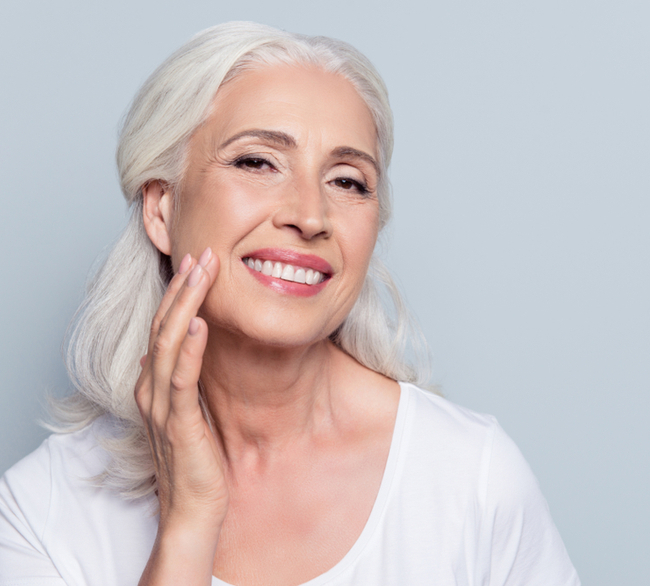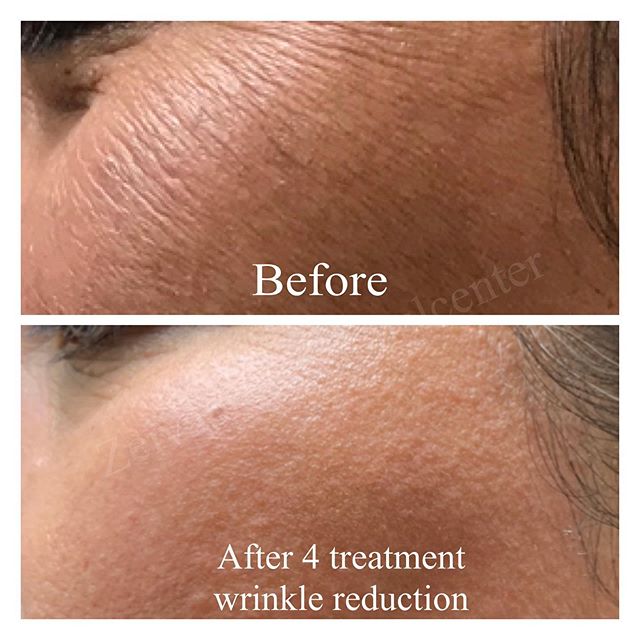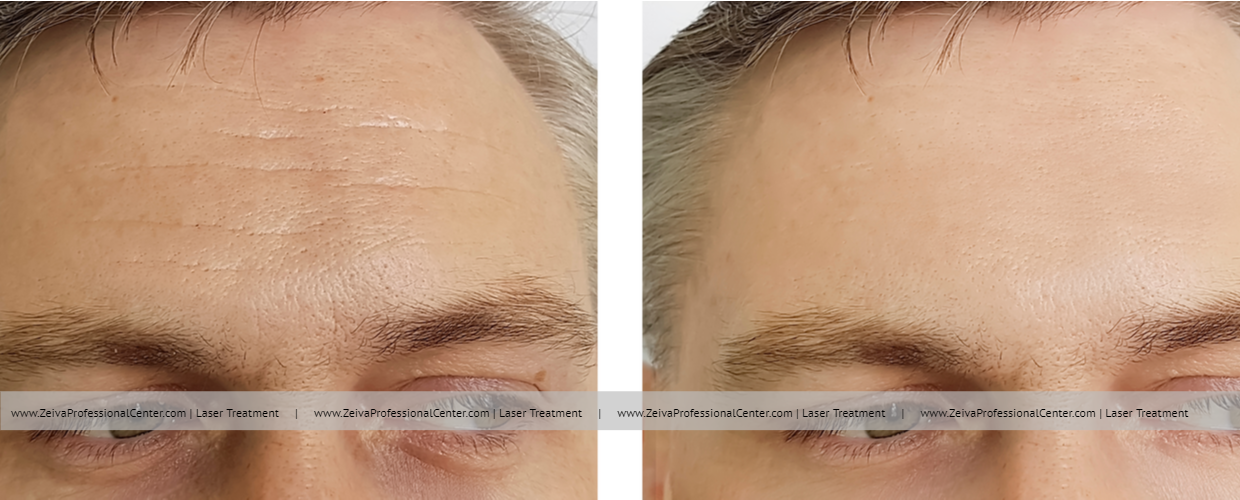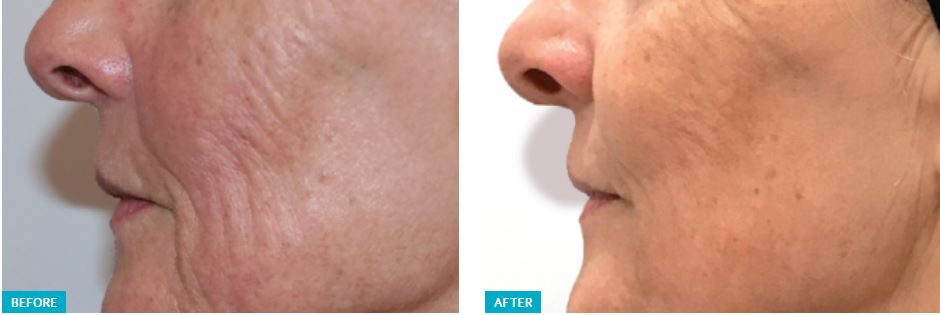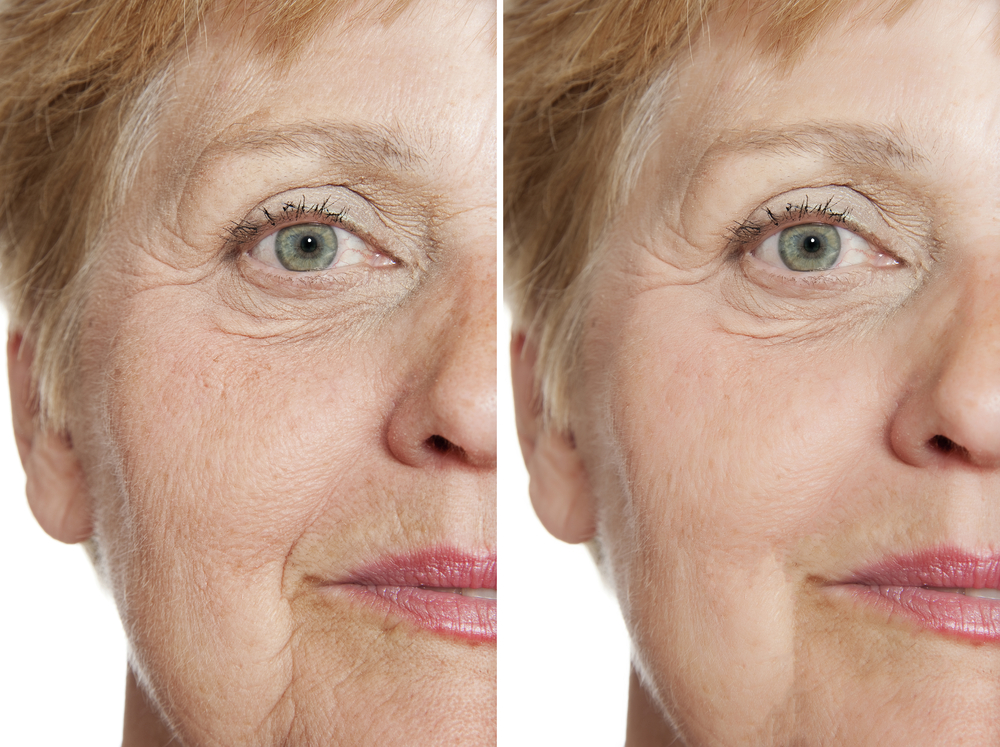WRINKLES
What Are Wrinkles?
Wrinkles are lines and folds that form in skin. They appear as a natural part of the aging process, but other factors—particularly sun exposure—play a major role in their development. Wrinkles range in size and severity from fine lines to deep furrows and grooves.
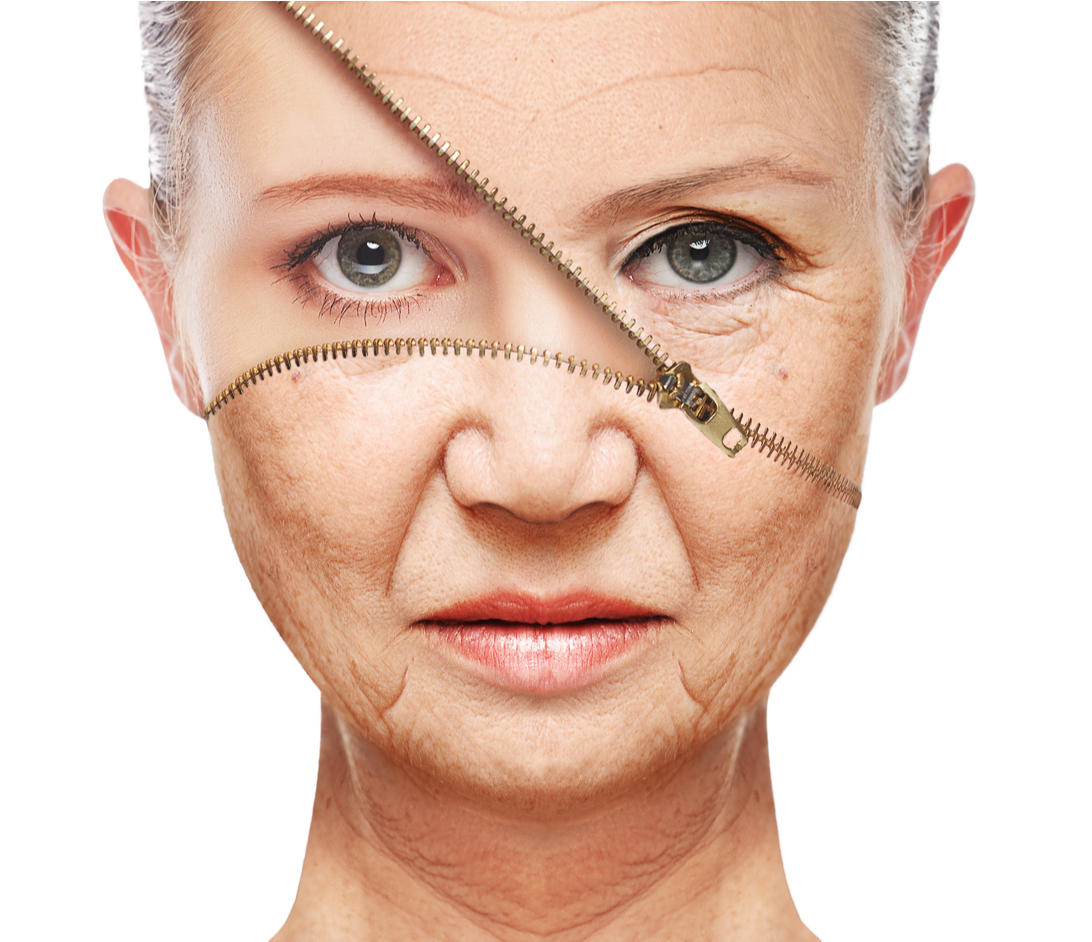
Most people tend to start noticing wrinkles in their 20s, since the body’s ability to produce collagen naturally starts to decline at age 25. In addition, there are other contributing factors—such as sun damage; your diet; smoking; and the onset of menopause, which can speed up collagen depletion. Wrinkles tend to be more visible if you are facially expressive. They tend to be most visible under the eyes and around the mouth, where the nasolabial folds (smile lines), lip lines, and marionette lines deepen over time.
Wrinkles are also common in places that get the most sun exposure, such as the face and neck, arms, and the backs of the hands. But not all wrinkles are created equal. In fact, there are four main types of wrinkles.
Atrophic crinkling rhytids
Look like fine lines, running in parallel. They indicate a loss of elasticity and usually occur when collagen in the skin atrophies with age. You can often see these wrinkles under the eyes.
Permanent elastotic creases
Are the result of sun exposure. These wrinkles are usually found on the cheeks, upper lip, and back of the neck. They’re more common in people with light skin.
Dynamic expression lines
As the name indicates, are caused by repeated facial movement. They include crow’s-feet and glabellar lines (known as “elevens”). They can also be named for the movement that creates them, like frown lines or smile lines.
Gravitational folds
Look like sagging skin, and they’re the result of the pull of gravity over time, as you can see in deep nasolabial folds. Weight loss and the general fat loss in the face can also intensify the look of these lines.
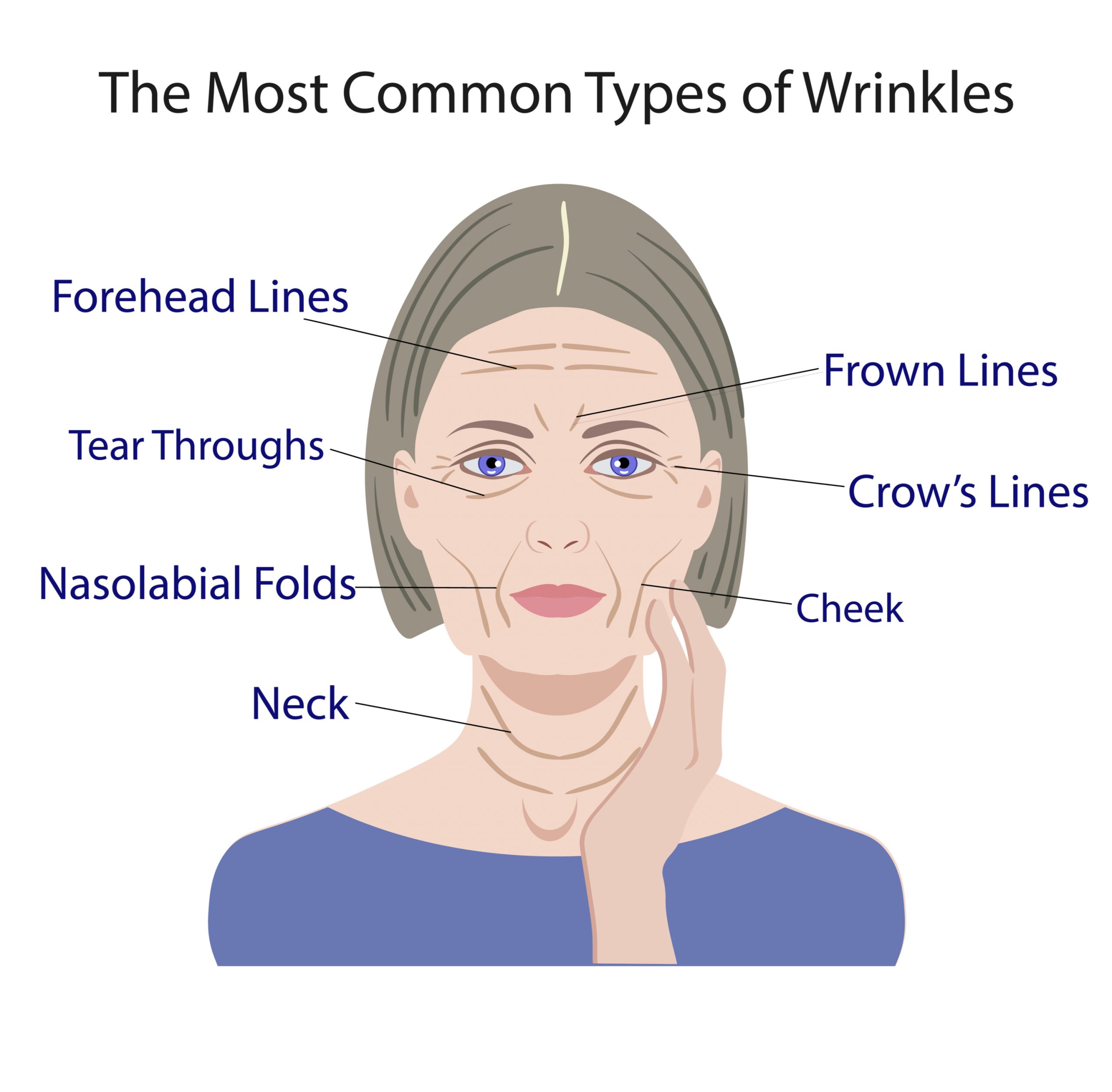
WHAT CAUSES WRINKLES?
Genetics plays a large role in your skin’s structure and texture, but sun exposure is a major cause of wrinkles, especially in people with fair skin, according to the Mayo Clinic. In fact, up to 90% of the visible skin changes commonly attributed to aging are caused by the sun. UV light damages collagen and elastin, which are the connective tissues that give skin its firm, supple texture. Without these support structures, skin becomes loose or slack, contributing to the appearance of wrinkles.
Make sure, if you do go out, to avoid the sun during peak hours (from 10 a.m. to 2 p.m.). By doing this, you can reduce sun exposure by as much as 60%. If outdoor activities during these peak times are necessary, encourage the use of protective clothing and sunglasses, suggest playing in shaded areas, and of course, always use sunscreen.
Other factors that can contribute to the formation and intensity of wrinkles include:
Age
Skin thins with age, becoming more fragile and delicate. Your skin also produces less oil, making it drier and more likely to look wrinkled. Fat erodes in the deeper layer of skin, which adds to the pronounced look of wrinkles.
Facial Expressions
Every time you squint, scowl, or smile, a groove forms in the skin around the facial muscles involved in the movement. Over time, skin doesn’t bounce back as well as it once did and creates a more permanent groove.
Smoking
Lighting up accelerates premature aging by affecting the skin’s blood supply. The harmful free radicals produced by smoking also take their toll. Repeatedly pursing your lips around a cigarette also doesn’t help.
TREATMENT OPTIONS
Types of Wrinkle Treatments
First, we would be remiss if we didn’t point out that prevention can go a long way. You’ve heard it before, but we’ll say it again: apply sunscreen with an SPF of at least 30 every day. Not only does sunscreen help prevent the formation of wrinkles, but one study found that daily application actually reversed existing signs of sun damage, including wrinkles. Regularly applying moisturizer helps too; hydrated skin looks plumper.
In-office treatments like lasers and neuromodulators (like Botox®) can also reduce existing wrinkles. The best treatment for you depends on what kind of wrinkles you have, so start with a consultation to learn about your options.
In the world of beauty, where youth remains the holiest of grail, it can seem like every treatment on the market promises to eliminate fine lines and prevent all future wrinkles in just six weeks’ time. You’re right to be skeptical of a $20 cream’s ability to take years off your face, because while anti-aging claims abound, only a select few ingredients and technologies have actually been proven to help with wrinkle reduction—and it’s of crucial importance to know what works and what’s just marketing.
In-office treatments
“What makes this [category] so challenging is that there are a lot of options out there, and I would say that no one provides the perfect solution alone,” says Zeiva. “In-office treatment will range from less invasive to more invasive, and certainly, I think that’s a reasonable curve to follow. As someone gets older, the skin becomes less elastic and there are more wrinkles and creases to deal with, so you have to use stronger technologies and stronger compounds to combat that.”
Neurotoxins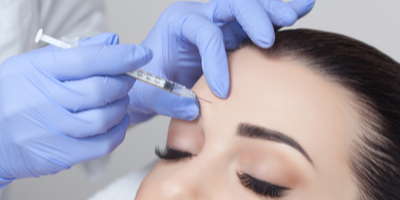
Neurotoxins, or neuromodulators, include injectables Botox, Dysport, Xeomin, and Jeuveau, and are arguably the most popular wrinkle solution. These toxins are injected into the treated area and work to temporarily paralyze the muscle beneath, thereby preventing movement and the formation or deepening of wrinkles. “We see [a lot of] preventative wrinkle management, especially with younger patients coming into the office and asking to get Botox and the like,” Zeiva notes. “The idea is that you look at someone in their early to mid-20s, and you don’t see much in the way of static creases, but when they start to move and frown and smile, you definitely start to pick up some creasing, so we start those neuromodulators much earlier now.”
Of course, these injectables are used on older patients as well, and while there will definitely be an improvement, they likely won’t take all preexisting creases away and can lead to drooping caused by weakened muscles over time. With this in mind, it’s important to start slow and conservatively; even then, neurotoxins may not be the best solution for patients with advanced creasing.
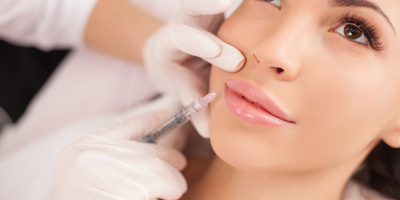 Fillers
Fillers
Where neuromodulators fall short is often where dermal fillers, another in-office cosmetic go-to, shine. “Fillers have been a mainstay for most cosmetic practices for several decades at this point, and they have become incredibly safe and easy to use,” says Zeiva. The side-effect profile is low, they’re great for a host of applications, and there are now more options than ever before. “For fine lines—the ones you’d find in the neck, the forehead, in between the eyebrows, and the crow’s-feet area—we do now have fillers that are very low molecular weight, and they can be injected very superficially, just under the skin,” Zeiva explains. “Older, standard fillers, such as Juvéderm and Radiesse, are great volume fillers that can help re-create cheeks and address major nasal-labial folds, but we now have choices like Restylane Silk and Belotero that allow us to go very superficially without worrying about getting lumps and bumps in the area.”
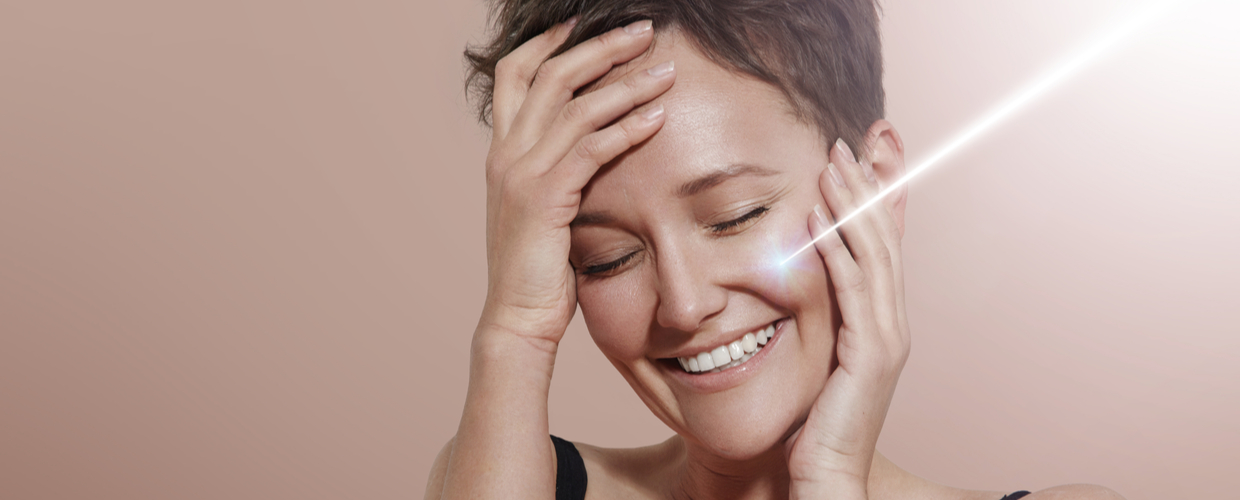
Laser resurfacing
In the same way that fillers address deeper creasing among older patients, a wide range of laser treatments can deliver amazing results that get to the root of the problem. “You have some nice lasers that are fractional in nature and are carbon dioxide–based, so instead of burning the surface area, they make multiple passes through which energy is delivered, and the healing time is much quicker—a couple of days of redness and discomfort rather than weeks of healing tissue,” Zeiva says. Fractional lasers are especially great for targeting fine lines and creases around the mouth, in the lower neck, and in between the eyebrows, and they allow the tissue to heal nicely, avoiding some of the pigmentation issues caused by other lasers. Among the most popular non-ablative (non-wounding) lasers stimulate collagen and exfoliate the surface of the skin, allowing scarring, fine lines, and hyperpigmentation to shed. The stronger, ablative fractional lasers, are typically reserved for older patients, who show more substantial signs of aging. They drive deeper into the skin, usually delivering more favorable results, but they also cause redness and may require some recovery time.
Chemical peels
Chemical peels use acid (often glycolic, salicylic, or malic acid) to target the foremost layer or layers of skin, diminishing the appearance of fine lines and wrinkles and evening skin tone. The mildest of peels, often referred to as “lunchtime peels,” are of the superficial variety, and these require little to no downtime. Deeper chemical peels generally use trichloroacetic acid at concentrations between 35% and 70% and require more recovery time, but they provide more optimal results for extreme photodamage, crepey skin, and scarring.
Microneedling
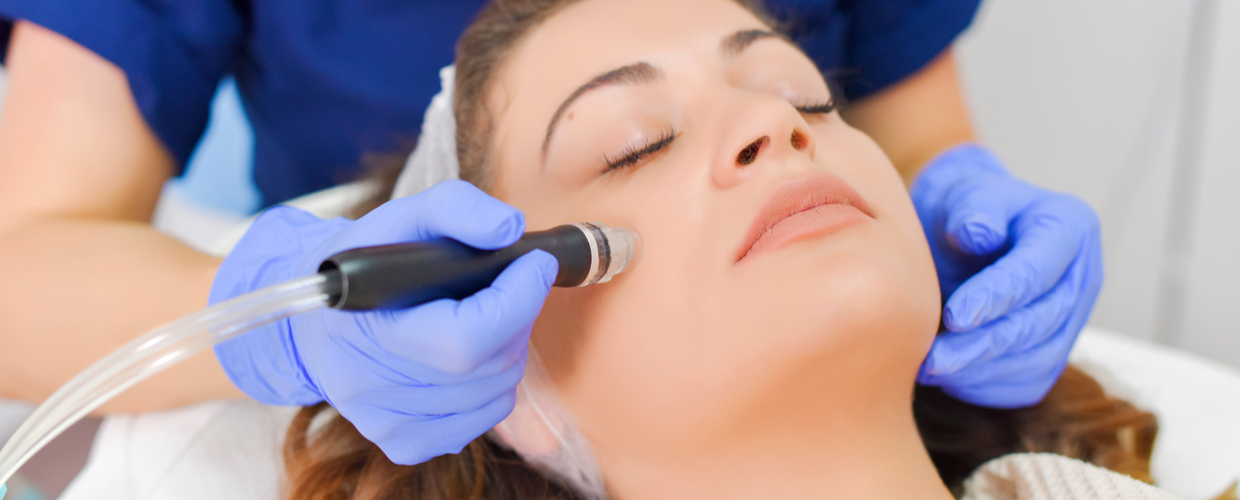 Although microneedling has been around for quite some time, its recent rise in popularity is due to the ways it’s been improved through radiofrequency and ultrasonic energy. With different types of microneedling treatments, tiny needles are used to penetrate the skin superficially, and while they are under the skin for a split second, energy is delivered and tissue is heated, creating a healthy layer of tightening and decreasing lines. Other treatments have taken microneedling even further, by not only piercing the skin but actually adding in beneficial nutrients and ingredients. “With microneedling, we can combine a really small amount of hyaluronic acid, vitamin C, glutathione, and even Botox, so you get an immediate plumping and glowing effect,” Zeiva says.
Although microneedling has been around for quite some time, its recent rise in popularity is due to the ways it’s been improved through radiofrequency and ultrasonic energy. With different types of microneedling treatments, tiny needles are used to penetrate the skin superficially, and while they are under the skin for a split second, energy is delivered and tissue is heated, creating a healthy layer of tightening and decreasing lines. Other treatments have taken microneedling even further, by not only piercing the skin but actually adding in beneficial nutrients and ingredients. “With microneedling, we can combine a really small amount of hyaluronic acid, vitamin C, glutathione, and even Botox, so you get an immediate plumping and glowing effect,” Zeiva says.
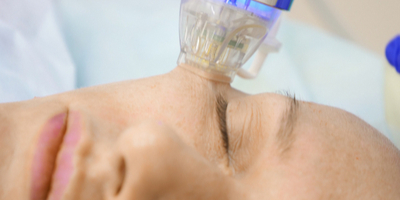
Dermabrasion
“If you do get into a situation where creasing is becoming a little bit more advanced, it can be helpful to rely on some of the older techniques as well. Dermabrasion, for example, can be a great tool for wrinkle management because it literally takes off a layer of skin until you get to the depths of the wrinkle, but it’s a bit more invasive and has a longer downtime. The treatment is essentially a deep exfoliation that uses a rapidly rotating instrument to more or less sand down the outer layers of skin, producing a smoother and younger-looking result.
Cosmetic surgery
“The foundation of the face is really important, and fillers, neuromodulators, lasers, and the like can only do so much,” the American Board of Plastic Surgery. “If there’s significant aging, changing the foundation can create a scenario where wrinkles are much less challenging and thus require less Botox and less filler to deal with.” Face lifts, brow and forehead lifts, and eyelid surgeries are on the more extreme end of solutions and will deliver the most impactful results—but even they require maintenance over time.
Wrinkle-reducing ingredients
While in-office treatments can work wonders, the truth of the matter is that most anti-aging happens at home. The skin-care industry, however, is more saturated than ever, and it can be challenging to identify which ingredients and products will actually reduce and prevent wrinkles and lines. “I think that the key to today’s existence in such a busy marketplace is to really understand what you’re applying and [for] what type of problem, because not every tool we have is applicable to the same problem,” notes Zeiva
Retinol
Retinoid is an umbrella term that refers to any skin-care ingredient derived from vitamin A, an antioxidant that helps protect the skin. Whether in the more concentrated form of a prescription retinoid, or in the over-the-counter variation, vitamin A is an essential nutrient for promoting cell turnover, stimulating collagen, and improving the appearance of fine lines. Beyond the differences in concentration, the major distinction between prescription and OTC retinoids is their formulation. Prescription retinoids contain vitamin A in the form of retinoic acid and are very fast-acting, while OTC retinols contain the ingredient in a form that your body must work to convert into retinoic acid. That means, when you apply retinol-infused products purchased at drugstores or beauty counters, it can take up to six months or even a year to really see results. But with the lower concentration and lag time comes a gentler, less drying effect. For the best results, start with a low concentration of retinol applied only a few nights a week; then, as you develop tolerance to the ingredient, increase either the concentration or the frequency.

Hydroxy acids
Most people have, at some point or another, used a product or two that contains hydroxy acids. Their names—glycolic, salicylic, lactic—are familiar, and their anti-aging efficacy is widely accepted, but what each does is slightly more nebulous. All hydroxy acids fit into two categories: alpha hydroxy acids (AHAs) and beta hydroxy acids (BHAs). Both come from similar sources, like plants and food, and they work in similar ways, but each delivers different results. The biggest distinction, however, is that AHAs are water-soluble, while BHAs are lipid or oil-soluble, making them more effective on oily skin. One of the most common AHAs is glycolic acid, the smallest hydroxyl acid molecule and long considered to be the best AHA because it penetrates skin deeply and quickly. Lactic acid, another AHA, is a larger molecule that’s gentler than glycolic, but it is still a great source for exfoliation and skin lightening. Sitting proudly on the BHA side is salicylic acid, which is able to both kill dead skin cells on the surface and sink into pores to dissolve the oil and bacteria that lead to acne. When starting with any hydroxy acid product, it’s important to start slowly, consult your doctor, and use a daily sunscreen to remedy increased UV sensitivity.
Hyaluronic acid
Hyaluronic acid, which is naturally found in our skin and is able to retain a thousand times its weight in water, consistently outshines other ingredients that promise plumper, smoother, softer skin. As we age though, the amount of naturally occurring hyaluronic acid steadily decreases, resulting in more obvious fine lines and creasing.
When picking a hyaluronic acid cream, lotion, or serum, it’s important to ensure that the molecule used isn’t too large to deliver hydration deep into the skin. “When the molecule is larger, it just sits on the surface of your skin and will draw moisture from your environment,” explains Zeiva. “If you’re in a moist environment, that will be great because it will plump all the fine lines on your skin—but it’s not going to penetrate any deeper than that. In the worst-case scenario, if you’re in a dry environment, it’s actually going to draw that moisture from deep inside your skin. So superficially, you’ll look plumper, but it will make your skin feel thirsty.” It’s a good idea to find a product that has different sizes and weights of hyaluronic acid molecules, so it attracts and holds moisture at every level.
Peptides
In the simplest of terms, peptides are strings of amino acids, which are essentially the building blocks of proteins in our body, including collagen and elastin in skin. Without these proteins, wrinkles start to appear and firmness fades, not to mention that peptides serve as a biologic messenger and are necessary for most bodily functions. Like hyaluronic acid, peptides are obviously naturally occurring in the body, but according to experts, we lose 1% of our remaining collagen annually after age 30, and our skin’s natural communication channels will slow as a result.
Introducing exogenous peptides to the skin in the form of a topical product more or less tricks the body into thinking it needs to heal, and it then stimulates collagen production. While there are hundreds of peptides, some are far more effective and better for skin than others. Carrier peptides deliver trace minerals to boost collagen; signal peptides send messages to skin to produce collagen and elastin; enzyme inhibitor peptides slow down skin’s natural breakdown of collagen; and neurotransmitter peptides block the release of chemicals that create muscle contraction and, eventually, wrinkles.
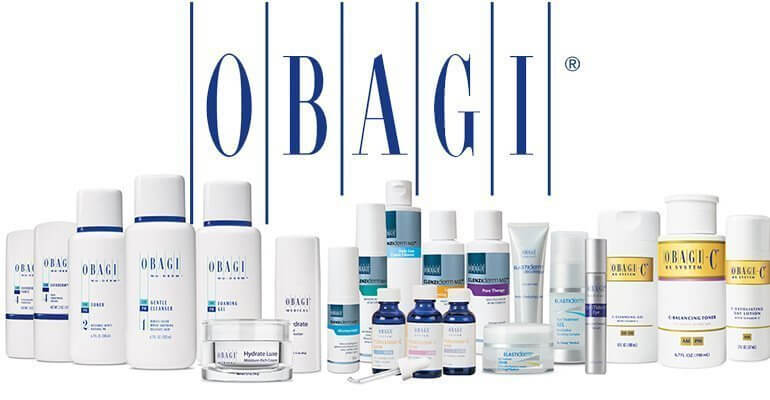 Vitamin C
Vitamin C
Long known for protecting skin from UVA and UVB damage and for reducing hyperpigmentation, the antioxidant, which boosts collagen production and firms skin, is a great tool for wrinkle prevention as well. Vitamin C works by targeting the superficial top layers of skin, leaving a collagen-rich, brighter complexion behind. But finding (and keeping) a vitamin C product, with the ingredient’s short life span, can be somewhat tricky. “Vitamin C can be broken down very easily by changes in temperature and light,” Zeiva explains. “It’s an antioxidant, so the very environmental stresses that it protects us from, like air pollution and sun, cause its own deterioration.” Ideally, she says, you want it to be in an airless delivery container that allows in little to no light like Obaji-C Rx System.
Other antioxidants
While vitamin C may be the most effective and certainly the most popular antioxidant for fighting wrinkles and fine lines, it’s far from the only option. From green tea to niacinamideand beta-carotene to phenolic acid, antioxidants are naturally occurring and are crucial ingredients for maintaining elasticity and blocking free radicals.
We carry both Zo® Skin Health and Obagi Nu-Derm® cosmeseuticals.
Real Clients – Real Results
Daniella
★★★★★
“Great experience!! Zeiva is so knowledgeable. My daughter and I are definitely going back!!”
Dorothy
★★★★★
“Very professional! Just one treatment and I believe I already see an improvement!”
Helga
★★★★★
“I had the best experience here at this center. Very clean. Very professional. They went above and beyond, and I will definitely stay a long-time customer.”
Betsy
★★★★★
“I ❤ this place! Very professional and great prices. Excellent service!”
TREATMENT
We can help…
We’re here to help you achieve your desired look.
Choose from a variety of skin rejuvenation & body contouring procedures, along with corrective treatments for scars, unwanted hair, age spots and tattoos.
Our technically certified cosmetic estheticians will work with you to enhance your natural beauty.
Schedule a consultation today!
